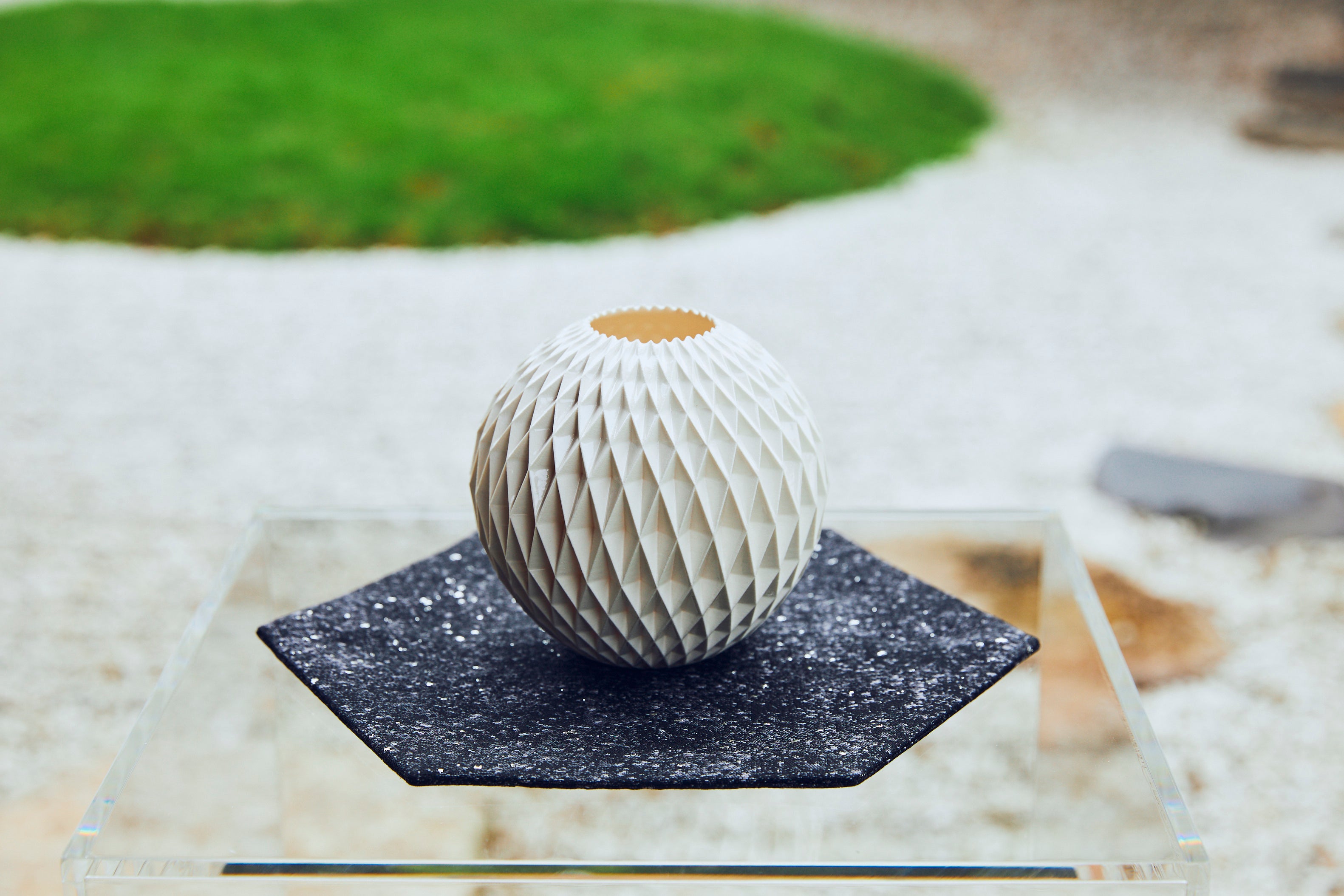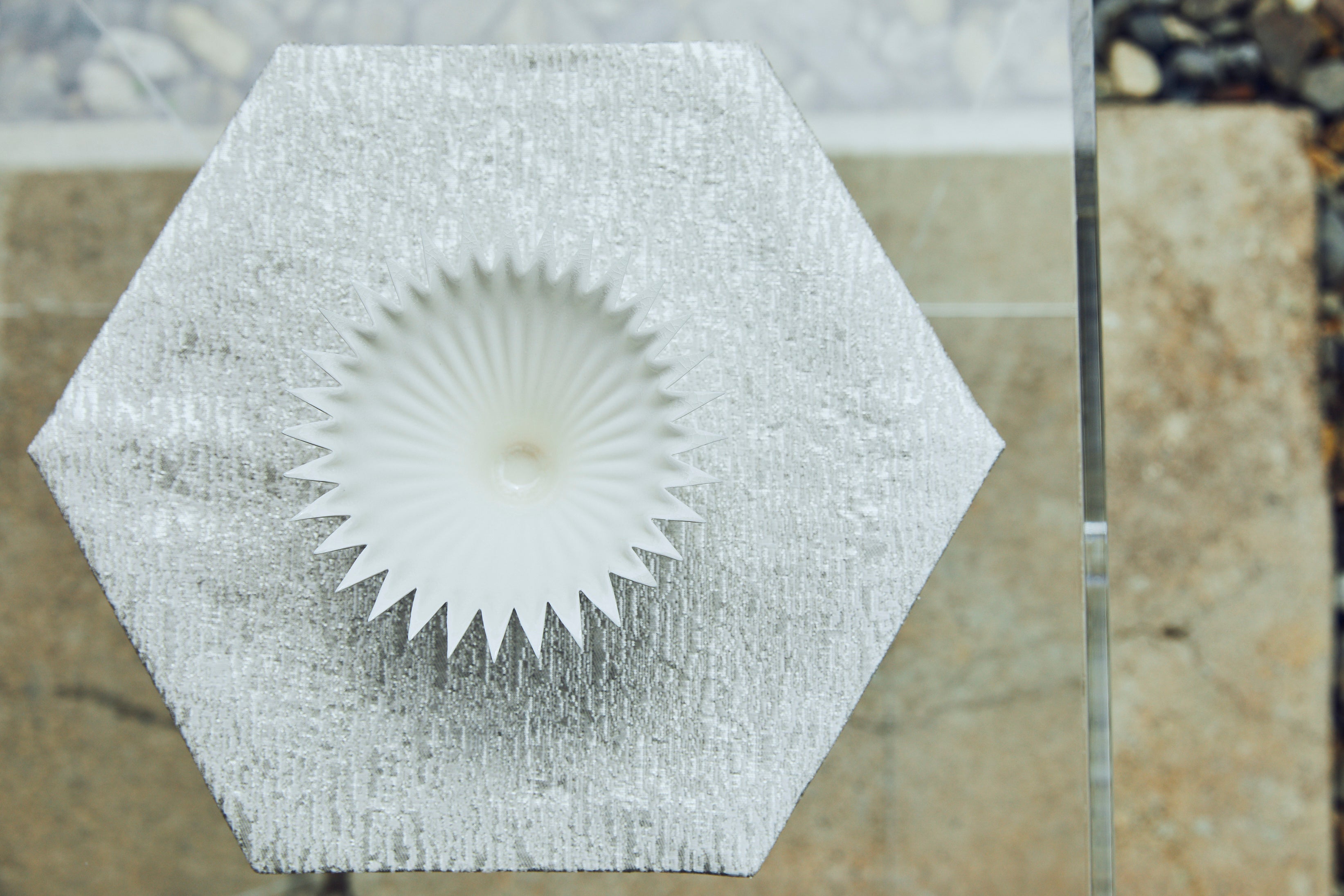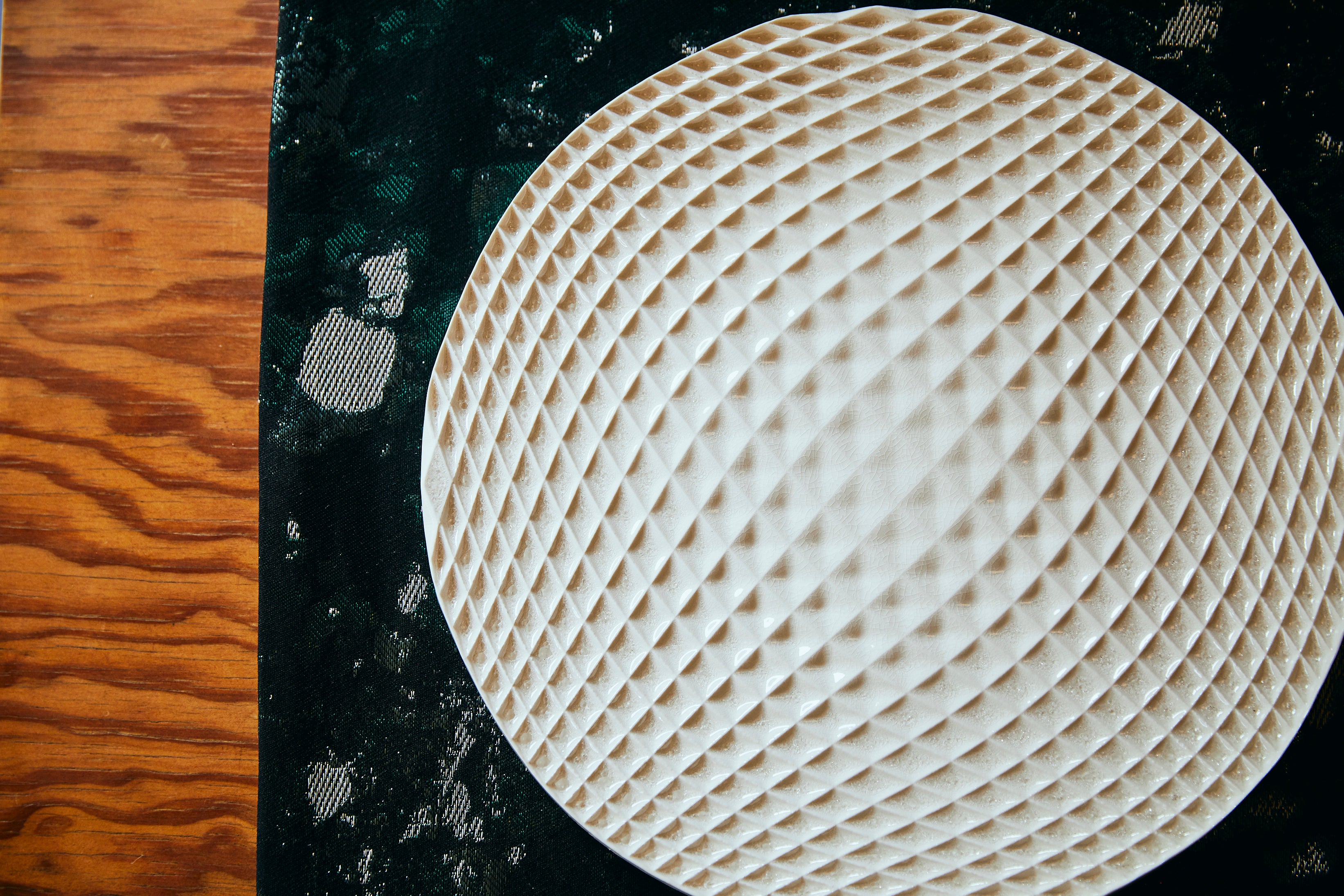Interview
Yuki Nara (ceramist and architect)
Yuki Nara continues to engage in innovative creative endeavors in the two fields of pottery and architecture.
The new Lotus series, unveiled at Kasuien in Kyoto in July, was inspired by HOSOO textiles.
For this exhibition at Kasuien, Nara collaborated with Hosoo Masataka, the 12th generation head of the Hosoo school, and Obara Hiroki, the 5th head of the Ohara school of Ikebana.
We bring you an interview with Nara, in which he talks about his thoughts on HOSOO and his philosophy on his own creative activities.

The appeal of HOSOO textiles
Through this collaboration, I was shown HOSOO 's textiles, and I was particularly inspired by the "Paragon" textile. It has a cross-like pattern, and I felt it had something in common with the diamond-shaped vectors I use in my work. Inspired by this pattern, the motif of my new piece, " Lotus ," was born. Of course, the size and materials of the ceramics and textiles are different, but if you look closely, you can see that there is a sympathy between the two works.

I think it would be good to make the HOSOO styling mat and my work on it completely different and contrast them. An unexpected combination that makes you think, "Why would you match this ceramic with this textile?" But this time I didn't go in that direction, but rather thought of my work as mimicking or resembling the textile. That way, I think the mat and my work resonate more. What you see there is ceramics seen from the perspective of textiles, and textiles seen from ceramics. In that sense, I want my work to bring out the textiles, and vice versa.


HOSOO textiles look flat when viewed from a distance in photographs, but they are very three-dimensional when viewed up close. There is an aesthetic that is created by overlapping layers and overlapping fabrics. A macro world when viewed from afar, and a micro world when viewed up close. I think that the inclusion of both of these perspectives is close to art. That's why I felt that this was the only way.


The path forward for traditional crafts and art
When I was approached about this solo exhibition, I thought of my work in architecture, which is a parallel pursuit of my ceramics. For example, I might be asked to design a building to be built on a certain site in a certain place. Even if I come up with the design, the local people are naturally involved in the process of building the building. This includes craftsmen, people who are acquainted with the client, and there is a sense of creating something together with the local people. Even if we architects are involved in a satellite-like way, in a different place, we have meetings with the local people each time and create something together. We can learn about local information and the local culture. I find that aspect of architecture interesting.


Creating architecture is a completely different vector from creating ceramic works. Architecture naturally has the perspective of "taking place in a certain society." Moreover, architecture is created by a team. It is not an expression of one person, but a collaborative effort.
These two perspectives on architecture are also the philosophy of my ceramic creative activities. Ceramics is an expression of the individual, so what I do is contradictory, but I want to think about ceramics from an architectural perspective. In fact, this aspect may be apparent in this exhibition, which was a collaboration with Masataka Hosoo and Hiroki Obara. Although it is an expression of the individual, by mixing and relating to each other, a team is formed, and what is born from that team becomes something overwhelmingly new. That is the path that traditional crafts and art should take. That is what I believe.


The future of art is "media"
Masataka Hosoo often told me that he was "turning textiles into media." I didn't know what he meant before, but I feel like I'm starting to get it. Originally, textiles were meant to be "useful," practical objects. When he calls them "media," he means that they are clothing, a tool for expressing the body, and also a mirror of society.
 It's exactly the same as the architecture I do. Architecture is also something that is used by people, but the "box" of a building can become a symbol of a certain era. In that sense, architecture is a mirror of society. And not just architecture, but pottery as well. Just like "Jomon pottery" and "Yayoi pottery," pottery is also a mirror of each era. I think that's what Hosoo is referring to when he says "media."
It's exactly the same as the architecture I do. Architecture is also something that is used by people, but the "box" of a building can become a symbol of a certain era. In that sense, architecture is a mirror of society. And not just architecture, but pottery as well. Just like "Jomon pottery" and "Yayoi pottery," pottery is also a mirror of each era. I think that's what Hosoo is referring to when he says "media."
 Art and the arts are often thought of as something narcissistic that expresses something inside. "This is my work, what do you think?" Of course, there are people who are saved by such works, and the social demand for such works may be what it is. But I think that art in the future needs to be a medium.
Art and the arts are often thought of as something narcissistic that expresses something inside. "This is my work, what do you think?" Of course, there are people who are saved by such works, and the social demand for such works may be what it is. But I think that art in the future needs to be a medium.
 Is it enough to just have one's own "inner inspiration"? Of course there is inner inspiration, but if there is no element of media in it, I think art in the future will be selected out. I think that the perspective of thinking about "yourself in relation to society" will be increasingly required in the future. The question of "is it enough to just have inner inspiration" has always stuck in my mind, so when I heard Hosoo's concept of "media," I thought, "Maybe we're thinking the same thing."
Is it enough to just have one's own "inner inspiration"? Of course there is inner inspiration, but if there is no element of media in it, I think art in the future will be selected out. I think that the perspective of thinking about "yourself in relation to society" will be increasingly required in the future. The question of "is it enough to just have inner inspiration" has always stuck in my mind, so when I heard Hosoo's concept of "media," I thought, "Maybe we're thinking the same thing."

The exhibition "Ambient Weaving - Environment and Textiles" is currently being held at HOSOO GALLERY. I thought that "textiles as a medium" truly embodied this. Until now, "textiles" were complete in themselves, but now by reading environmental information such as temperature and humidity, they incorporate the surrounding environment and become a medium. That is exactly what I want to do. The way a work looks changes depending on where it is placed and the environment, and it changes as it absorbs light. In that sense, I think that the direction of what I am aiming for is very similar to Hosoo's. Naturally, our works are similar in our ideas. What Hosoo and I are doing now will surely become the "standard" in another generation. I think that the future of art lies there.
Yuki Nara
Born in Kanazawa, Ishikawa Prefecture in 1989. Graduated from the Department of Architecture at Tokyo University of the Arts in 2013 , and completed a degree at the Tajimi City Ceramic Design Institute in 2016. Graduated with honors from the Graduate School of Fine Arts, Tokyo University of the Arts in 2017 , and will run the architectural design firm EARTHEN from 2021. In the field of ceramics, he has been invited to exhibit at Art Basel/Design Miami (Switzerland), TEFAF (Netherlands), SOFA (USA), and other exhibitions. His major awards include the Special Jury Prize at the Kanazawa World Craft Triennale ( 2017) . His works are housed in museums such as Nezu Museum (Tokyo) and the Victoria & Albert Museum ( UK ) . In the field of architecture, his major works include "Shoji Teahouse" (2018 / 21st Century Museum of Contemporary Art, Kanazawa, Tainan Art Museum ) . In 2021 , he was selected as a finalist for the Under 35 Architects exhibition 2021, a gateway for young architects. Based in two locations, Kanazawa and Tokyo, he is engaged in creative activities that straddle the two fields of ceramics and architecture.

